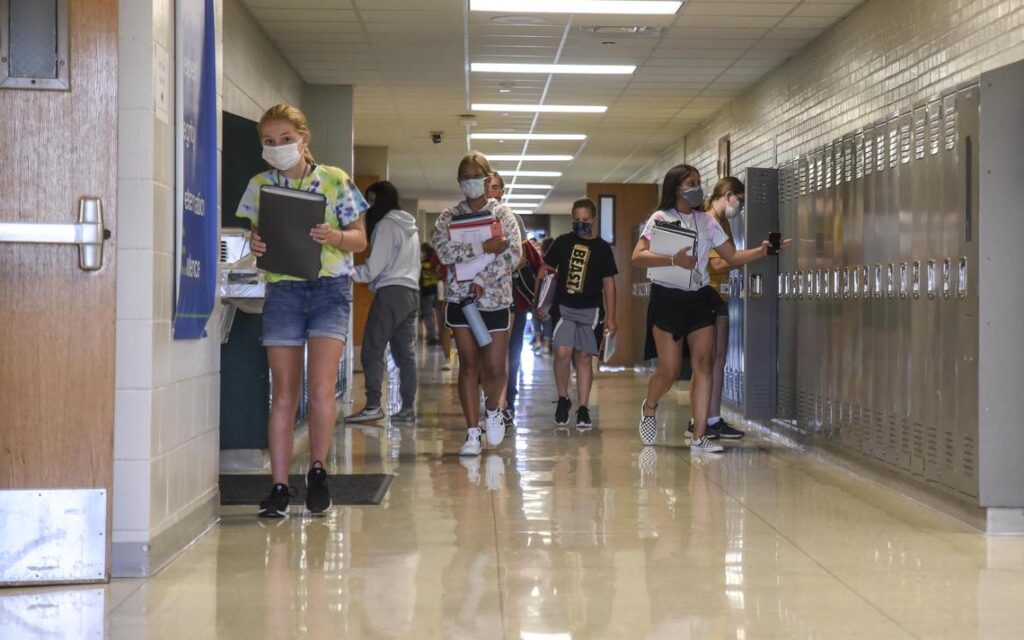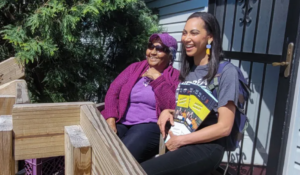This week brought a flurry of decisions around school police in Chicago. What to know

After protests for racial justice last summer brought renewed urgency to student activists’ demands to end policing in schools, Chicago high schools faced a critical decision: Would they remove police officers from campus or maintain their force of school resource officers?
The district tossed the hot-button decision to Local School Councils — volunteer groups comprised of parents, teachers, and community representatives that govern individual schools — with a 20-page slide deck and little time to prepare.
Last year, 17 schools voted police out; about 55 voted to keep them. This spring, they once again had the chance to decide. Councils had until Wednesday to vote on a plan.
Here’s what we know so far:
What exactly were schools trying to decide?
Councils were weighing how many school resource officers, or in-school police, to retain on their campuses. This year, they could opt to keep all, some, or none of their officers. Last summer, schools that voted to cut SROs from their campuses lost district dollars that would have supported those officers. Now, they get to keep those funds. If they voted to reduce SRO presence, schools also needed to determine how to allocate their remaining safety budget. (Click here to read more about those alternatives.)
At last count in this round, at least 22 high schools voted to eliminate one or more officers, while at least 16 voted to keep them by this week’s deadline, according to votes compiled by Block Club Chicago and Chalkbeat.
Who’s making the decision?
LSCs have had a few months to consider safety plans informed by district recommendations. Schools without LSCs are making safety decisions based on community meetings with administration, staff, and parents.
The district’s recommendation process hinges on a “Whole School Safety” steering committee. That committee, made up of five community organizations, laid the framework for councils looking to replace police and offered guidelines schools could consult to design alternative safety programs. The group in March recommended methods for investing in student mental health and engaging with de-escalation strategies, among several other specific and actionable measures.
One of those measures is the implementation of holistic restorative justice, which involves peace rooms, peace circles, peer juries, and de-escalation training on an ongoing basis. Schools should train a staff member or bring in a community practitioner to support restorative justice efforts, according to the committee’s recommendation.
What happened the last time schools voted on police?
Although nearly a year of remote learning ultimately rendered the decision irrelevant, most schools voted last summer to keep SROs on campus.
Of the more than 70 schools with school resource officers on campus, 17 voted to remove SROs from schools. More than half of those schools were on the North side. Two were mostly Black. Here’s our tracker of the final tally.
More than two dozen voting schools last summer either couldn’t reach a quorum (at least 7 members of an LSC must be present to vote on a plan), had a non-functioning LSC (not enough active members), or didn’t have an LSC at all. Those schools voted on SROs after convening community meetings with parents and school leaders. Nearly all of those schools without functioning LSCs served primarily Black and Latino students from low-income families. All but three of those schools voted to keep SROs.
Why were the meetings last summer so controversial?
Many schools last summer also failed to conduct the meetings with transparency. Some councils voted to keep police without posting public meeting information online in advance, and others limited reporter access and public dialogue. Chicago Public Schools posted the results of last summer’s LSC votes on its website in August after pressure from local journalists, and recently posted a tracker for this year’s votes.
What about schools that don’t have LSCs?
About one-fifth of the district’s schools either didn’t have enough LSC members to vote on school safety plans, or they didn’t have an LSC at all last year, according to data obtained by parent advocacy group Raise Your Hand.
RYH executive director Jianan Shi noted more schools have functioning LSCs this year than last year, but a significant number of schools still don’t have quorum. Manley Career Academy High School, Al Raby School for Community and Environment — both in Garfield Park — and Englewood STEM High School are examples.
The district urged these schools to convene and poll “the school community” to reach a consensus about safety. However, these polls aren’t binding — the principal and network chief are responsible for making the final call.
For schools like Englewood STEM High School, the principal, network chief, and sergeant met with key community figures, such as members of the Englewood Community Action Council to develop a safety plan. This summer, Englewood STEM opted to reduce its SRO force by one officer.
Denise Dyer, a member of the Englewood CAC and a partner with Community Organizing and Family Issues, said she felt that parents and community members had a solid chance to make their voices heard leading up to the meeting. She doesn’t feel the same way about LSC meetings.
“If the principal wants to go one way, most of the time, the CPS staff on the LSC is going to vote whatever way the principal wants to vote,” Dyer said. “And how’s the principal gonna vote? Whatever CPS is pushing.”
What is the national conversation?
Civil rights groups are calling on the Biden administration to shrink the role of police in schools, asserting that punishments disproportionately targeting students of color violate students’ civil rights.
After Minneapolis police officer Derek Chauvin murdered George Floyd last summer, public schools in that city cut ties with the police department. Denver and Seattle school leadership took similar steps to phase officers out of classrooms. So did Los Angeles. Chicago’s school board held back from making a centralized call.
The federal government has been involved in school discipline conversations since 2014, when the Obama administration released guidance for reducing suspensions and expulsion. The Trump administration later revoked that guidance.
Now, with Biden’s department of education seeking public input on discipline policy, experts anticipate the administration could soon issue a policy change.
This article was originally posted on This week brought a flurry of decisions around school police in Chicago. What to know





